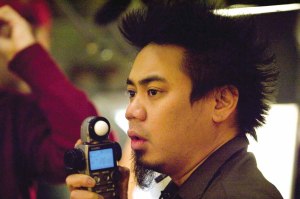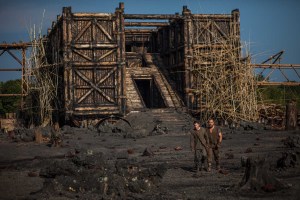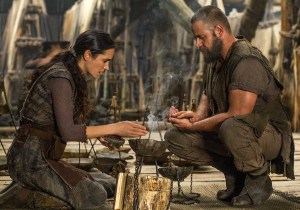
To refer to Matthew Libatique as a long-time Darren Aronofsky collaborator is to indulge in enormous understatement. Libatique has served as director of photography on all but one of Aronofsky’s features since his black-and-white 1998 debut Pi, including Black Swan and Requiem for a Dream. Work outside the collaboration includes studio features like the first two Iron Man films and Cowboys and Aliens. Libatique’s involvement in Noah began “officially about 14 weeks” before the start of principal photography, although “just for discussion socially, you can add a couple of months. It’s something Darren had been talking about for years. We discuss his feature projects often before there’s even a screenplay.”
Originating photochemically was an early decision. “It was predetermined by the two of us that we would shoot film. We were thinking that this might be the last time. There was no intention to do it digitally.” While Libatique’s experience includes upscale and complicated productions, he wondered “when [Aronofsky] mentioned Noah to me, given how large it was, how are we going to approach this film within the construct of his working style.” Initial intentions were to maintain that style and shoot simply. “We said we’re going to get a single handheld camera, go to Iceland, and shoot it like we shot Pi,” said Libatique. “Then we saw the scale of the place, and broke our rule immediately.”

Despite a desire to showcase large-scale action scenes, Libatique still considers Aronofsky “a single-camera filmmaker. The only time we’re using two cameras is if we’re shooting two wide shots to warm up the scene. In the big battle scenes, day for night, rainy, in November, that was a largely four camera shoot. But any other film would be eight cameras. I think Tarantino works in a similar way, and perhaps Clint Eastwood. But it’s rare among mainstream American filmmakers.” Libatique shot Noah with Arricam LT cameras on Kodak’s 500T stock 5219, using Zeiss Ultra Prime lenses. “Darren has developed this language of subjectivity – for our purposes it was a 35mm lens that we’d use to follow Noah around from place to place. A lot of closeups were done on 50s and 65s – Darren doesn’t like to go too long because he likes the proximity of a camera.”
Only one film processing laboratory existed in New York at the time – New York Film Lab, which has since closed, “so to get the look I wanted texturally from the film was a struggle. It’s not like the days when a cinematographer could put it through a bath any way they wanted. I had to rerate the filmstock to achieve more grain or less.” Ultimately, though, Libatique “shot everything pretty straightforward, and because of the work that Mark Friedberg and Michael Wilkinson in wardrobe did, I didn’t have to add a patina. I didn’t want it to feel like Lord of the Rings. I wanted it to feel real.”
 The camera department included Libatique regulars, with A-camera and Steadicam operator Stephen Consentino, gaffer John Velez, key grip Lamont Crawford and focus puller Aurelia Winborn among “the first people I call when I go to New York.” The film was largely lit to f8 to allow the use of polarising filters, with their two-stop light loss, to hide the reflective sheen of water which would otherwise have revealed lighting locations. Achieving this stop required some elaborate setups, including one involving 18, 36,000W helium balloons and four 20-ton construction cranes. “We needed enough light to see an expanse. It a massive undertaking,” Libatique explained. He credits key rigging grip Craig Vaccaro as “a scientist and engineer. If he hadn’t been there the film wouldn’t have been as successful.” Final grading was done at Technicolor in New York by digital intermediate colorist Tim Stipan, with whom Libatique had previously worked on Black Swan.
The camera department included Libatique regulars, with A-camera and Steadicam operator Stephen Consentino, gaffer John Velez, key grip Lamont Crawford and focus puller Aurelia Winborn among “the first people I call when I go to New York.” The film was largely lit to f8 to allow the use of polarising filters, with their two-stop light loss, to hide the reflective sheen of water which would otherwise have revealed lighting locations. Achieving this stop required some elaborate setups, including one involving 18, 36,000W helium balloons and four 20-ton construction cranes. “We needed enough light to see an expanse. It a massive undertaking,” Libatique explained. He credits key rigging grip Craig Vaccaro as “a scientist and engineer. If he hadn’t been there the film wouldn’t have been as successful.” Final grading was done at Technicolor in New York by digital intermediate colorist Tim Stipan, with whom Libatique had previously worked on Black Swan.
“There’s a point to this film,” said Libatique. “There’s an allegory here that speaks to something that’s happening today. The choice that’s made, as to what’s in the scene and the compositions, is one of the most pointed things in the film, other than the dialogue.” Having just wrapped F. Gary Gray’s Straight Outta Compton, Libatique can convincingly claim to have “enjoyed a career where I can do a large film and a small one. Large and small present different challenges. I really enjoy being a cinematographer.”





